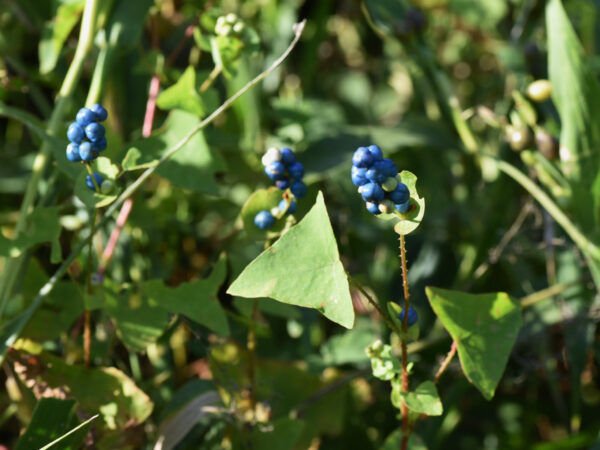PDF version coming soon

Mile-a-Minute (Persicaria perfoliata )
Species at a Glance
Mile-a-minute, also known as Asiatic Tearthumb, is an herbaceous, annual, trailing vine that can grow up to six inches per day. It survives by using its sharp barbs to attach to and climb over other plants to reach sunlight, weakening and smothering them in the process.
Species Description
The leaves of Mile-a-minute are light green and distinctly shaped like equilateral triangles. They are 3-8 cm (1-3 in) in length and alternate along a thin, delicate stem that can reach lengths of up to 6 m (20 ft). Barbs can be found both on the undersides of the leaves that curve downward along the stems. At each node along the stem, a cup-shaped leafy structure called an ocrea can be found. From the ocrea, flowers buds and fruits emerge. Flowers are small, white, and generally inconspicuous. The fruits are berry-like and a metallic blue color. They are arranged in clusters with each fruit containing a single glossy black or reddish-black hard seed. Some native vine species, including native tearthumbs, may be confused with Mile-a-minute; however, these native species lack equilateral triangle-shaped leaves and blue berry-like fruits.
Native & Introduced Ranges
Native to India and eastern Asia, the first population of this vine found in the United States was in York, Pennsylvania in the late 1930s when it was accidentally introduced through contaminated holly seed. Since then, Mile-a-minute has spread throughout much of Pennsylvania, and to all states in the Mid-Atlantic region, as well as Ohio, Kentucky, Massachusetts, and Oregon.
Biology & Spread
This self-pollinator produces a large number of seeds that can persist in the soil for up to six years. Seeds are carried long distances by birds, which are presumed to be the main cause of long-distance spread. Deer, chipmunks, squirrels, and even ants are known to feed on Mile-a-minute fruits, contributing to local seed dispersal. The seeds can also float in streams and rivers for 7-9 days, allowing them to travel long distances to new locations.
Habitat
Mile-a-minute generally colonizes open and disturbed areas along the edges of woods, wetlands, stream banks, roadsides, and uncultivated open fields. It prefers extremely wet environments with full sunlight, although it will tolerate shade for part of the day. Areas that are regularly disturbed, such as power lines and utility rights-of-way are prime locations for Mile-a-minute establishment.
Impacts
Threat to biodiversity
Infestations of Mile-a-minute grow rapidly and germinate early in the spring, producing a thick tangle of vines that overtake shrubs and other native vegetation. Each vine can reach lengths of up to 30 feet, overtopping, shading out, weighing down and even breaking taller herbaceous plants, woody shrubs, tree seedlings and saplings. It reduces native plant diversity by reducing access to sunlight and destroying stems and branches with its weight.
Economic Costs
Mile-a-minute destroys tree seedlings and saplings, creating problems for nursery and horticulture crops, tree farms, and forestry operations. It also quickly overruns utility rights-of-way where herbicides are used to control unwanted vegetation. Control and restoration costs of areas infested with mile-a-minute range from $150 to $1,240 per acre.
Prevention & Control
Several management techniques can be used to control Mile-a-minute; however, once established, it can be very difficult and expensive to eradicate, and on-going monitoring and management must occur for up to six years to exhaust any seeds remaining in the soil. Possible control mechanisms can include manual and mechanical control, such as hand pulling, mowing, or cultivating; chemical control with herbicides; and biological control using the mile-a-minute weevil, which is currently the most promising and cost-effective method.
References
Southern Indiana Cooperative Invasives Management. 2016. Invasive Plant Series: Mile-a-Minute Vine. Purdue Extension. Accessed from < https://www.extension.purdue.edu/extmedia/fnr/fnr-481-w.pdf>.
New York Invasive Species Information. 2019. Mile-a-Minute. Cornell University Cooperative Extension. Accessed from < http://nyis.info/invasive_species/mile-a-minute/>.



